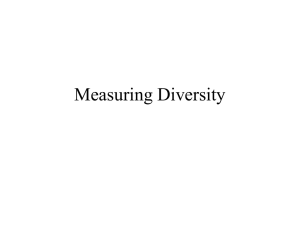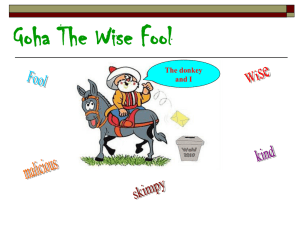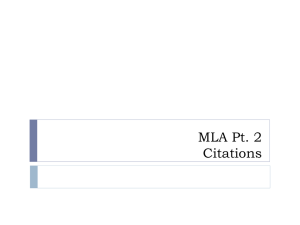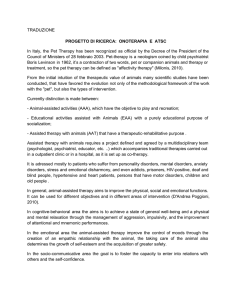Simpson and His Donkey - aiss-english-10
advertisement
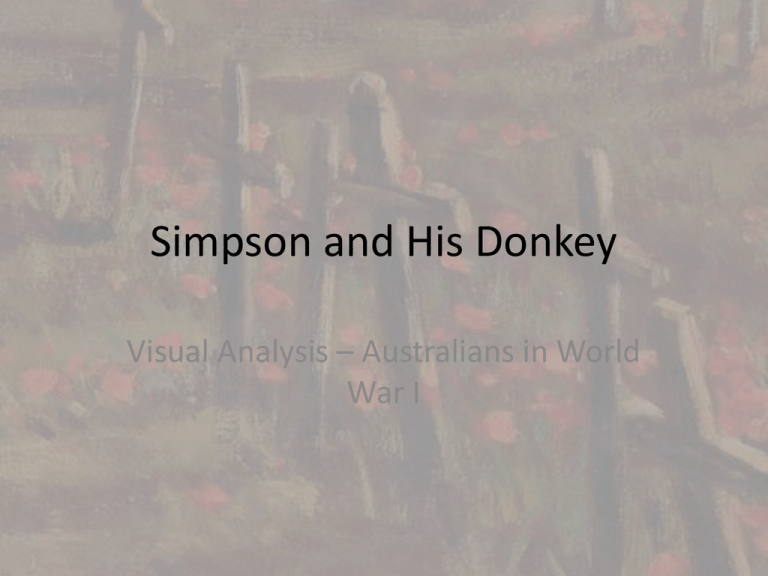
Simpson and His Donkey Visual Analysis – Australians in World War I What does it say about Australian Culture? • It represents the Australian as selfless and generous • Simpson put his own neck on the line to contribute to the war effort and he saved many, this portrays a heroic attitude which is stereotypical in Australian culture • It shows that Australians are more than willing to step up and take on responsibilities, regardless of the consequences Simpson and his Donkey • John Simpson Kirkpatrick was a famous ANZAC because he would carry wounded men on his donkey to safety. • This picture was painted by Horace MooreJones, who based it off a photograph shown to him in 1915 Objects and placement • Placed in the mid-ground of the painting is Simpson and his donkey who are the ‘subject’ of this painting, because they are all aligned it gives a sense of equality. • Upon the donkey is a wounded soldier, with Simpson supporting him. In a literal sense he is only one wounded man, but he represents thousands of men who scarified so much for the war • At the same time he is also representing the hundreds of men who’s lives were saved by Simpson and his donkey • There is reason to believe that even though the painting is of Simpson, Simpson has be used to represent the best of Australian at war and it is not always the best fighters that are remembered, but sometimes its those who sacrificed to most. Placement and shadow • Simpson, his donkey and the wounded soldier are placed right in the center of the picture making them the main focus. • The subjects take up a large portion of the page so that you are able to see their whole bodies and it allows for more detail on the people. • They have been painted so that your eyes are drawn to Simpson’s eyes, the painter has done this with an eye level shot, and he is staring right back at us. • The painting has been done so as to look as if the sun is beating down on the people and donkey in this picture. This has been done through the use of shadow. By Moore putting the shadow under the donkey it means the sun is directly above them, implying this is happening during the hottest part of the day. Background/setting • The background behind the focus of the picture is the hills of Gallipoli • This picture was painted in a way that to get the most out of it and to be able to understand this picture with the most depth is to have at least a basic knowledge of Gallipoli and the trenches. • It is common knowledge that during the First World War for the soldiers the safest place to be were the trenches. This Is because the trenches were the only form of cover. • However in the painting Simpson has left the safety of the trenches for a man who is wounded and there is a large chance he will die anyway • To signify the danger Simpson was putting himself in, in the background Moore painted in an explosion on a hill, just like the one the soldiers are on. Expression • Simpson, his Donkey and the wounded soldier have also been painted on a rather treacherous track, one slip could mean death. • What is more powerful, is the expression of Simpsons face, he is on the edge of the cliff, and his expression is blank and detached • By giving this expression to Simpson it gives the reader the impression that the man in the picture must know these cliffs like the back of his hand, to be able to be an inch from slipping to your death as any moment and appear to not care. • Meaning that this is a common thing for this man to do, so for even those who do not know the story of Simpson and his donkey, from this picture alone a good text analyzer could figure it out, because the story is told in the painting. Colour • The colour in this painting is all of a similar tone. It is all very dull, and brown. • Because everything is so dull your eyes are drawn to the few things that do not blend into that brown colour tone. • The first thing your eyes are drawn to due to the colour scheme is the soldiers blue shirts. And without the wounded soldier’s blue shirt against the brown he probably would not have been seen. • Before you notice the soldier who is wounded you notice the soldier leading the donkey. You see his blue shirt and then your eyes are drawn to his expression which says a lot about him, which I elaborated on previously. • The red used for the wound and the explosion also stands out so the ‘readers’ can see their significance. Conclusion • This painting was based off a picture seen by the creator, so a lot of his work was done for him. • However what really makes this picture it the small details, the expression of Simpson’s face, the colour choices and subject positioning. • This painting gives a good insight in to the Australian in the first world war because Simpson and his donkey were war heroes and many Australian Veterans owed him their lives. • And what better way to represent Australians in the First World War than a painting of a man who saved many lived by risking his own, whether it was bringing a man to safety of transporting supplies between the ships and the trenches. This is a painting of a man who Australians respect a man who's bravery will forever be remember and a man who has left a legacy that will live on forever in the memory of Australians.





